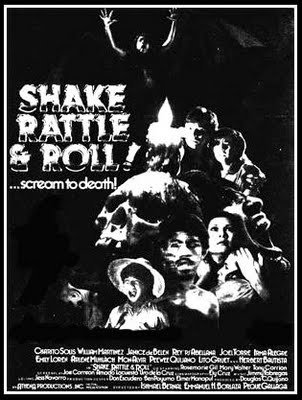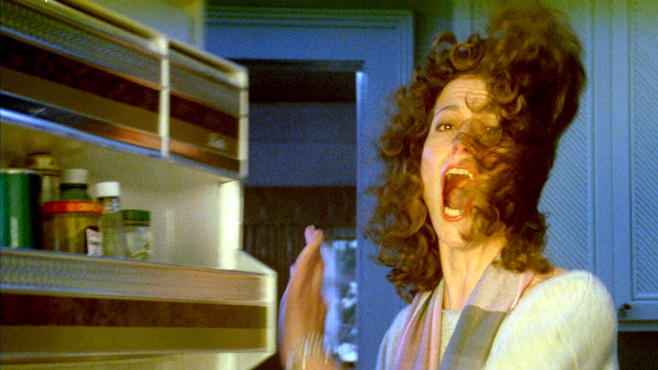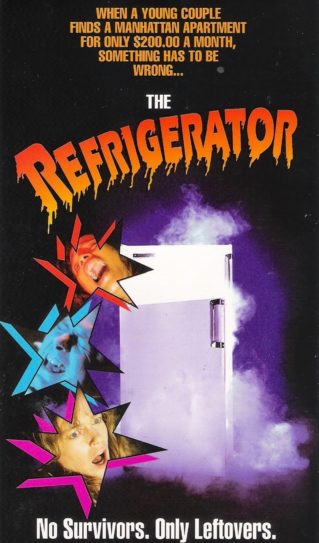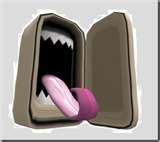 In the lexicon of household appliances the refrigerator is King Kong and Godzilla put together. Just look at all the horror movies that have used refrigerators as their subject: ATTACK OF THE KILLER REFRIGERATOR, THE REFRIGERATOR, the second part of the anthology film SHAKE, RATTLE & ROLL and several more I’ll be discussing below.
In the lexicon of household appliances the refrigerator is King Kong and Godzilla put together. Just look at all the horror movies that have used refrigerators as their subject: ATTACK OF THE KILLER REFRIGERATOR, THE REFRIGERATOR, the second part of the anthology film SHAKE, RATTLE & ROLL and several more I’ll be discussing below.
You just don’t see this range of cinematic inspiration when it comes to other appliances. Sure, the Japanese BATTLE HEATER attempted to make a heater into an object of fear, while Ruggero Deodato’s THE WASHING MACHINE introduced the concept of a washing machine as a murder weapon and Tobe Hooper’s THE MANGLER gave us a malevolent laundry folding machine. All those things have potential, but at best they’re the Rodan or Mothra of evil appliances, ranking far behind the refrigerator.
NFL legend William “the Refrigerator” Perry couldn’t have chosen a more effective nickname. The name referred primarily to Perry’s size, but I wonder if it had other, more sinister connotations. Perhaps the moniker served to strike fear into Perry’s competitors, and did so far more effectively than a more obvious choice like “the Chainsaw” or “the Sledgehammer.” By the same token, in 1984 a shot-on-video short called ATTACK OF THE KILLER REFRIGERATOR made a minor splash in cult film circles, outdoing the likes of MICROWAVE MASSACRE (1983) and WOODCHIPPER MASSACRE (1988) in popularity. True, ATTACK OF THE KILLER REFRIGERATOR isn’t exactly a household word among horror buffs, but the fact that this $25—yes, that’s twenty five dollars—project received any attention at all is fairly remarkable, and doubtless due to its subject matter.
Clocking in at around 15 minutes, ATTACK is a cheesy little number about a sentient refrigerator that gets pissed after some college pukes abuse it during a party, and so kills ‘em all off. Scenes of people getting limbs lopped off by the slamming fridge door are chilling, recalling a childhood game I played with my little sister in which I’d encourage her to stick her arms and legs inside our refrigerator and then yank ‘em out before the door (pushed by me) slammed shut. Refrigerators can be hazardous, as ATTACK proves, and it contains another, even more relevant message that was driven home for me a few years ago when I was overhasty in moving a refrigerator and threw my back out. Quite simply, the refrigerator demands respect!
Also from 1984 was the three-part Filipino anthology film SHAKE, RATTLE AND ROLL, whose middle segment “Pridyider” (“Frigidaire”) concerns a killer fridge. It’s one of the more effective such films, with a woman and her daughter moving into a house where an evil fridge holds sway, thus demonstrating the very real dangers of pre-owned refrigerators. The unforgettable climax involves a woman cooling herself in the open door of the refrigerator on a sweltering evening…and, after enjoying the feel of the cool air on her body a bit too much, getting sucked into the thing! Yes, refrigerators are sometimes used for purposes other than their intended ones, often to the user’s great detriment.
“Pridyider” concludes with a happy ending of sorts that sees the evil fridge defeated after its plug is pulled…but is this end truly a happy one? Think about it: you may be able to stop the flow of electricity powering an evil refrigerator, but all your food will go bad!
Another 1984 movie of note is GHOSTBUSTERS, whose heroine Sigourney Weaver sees a horrific vision upon opening her refrigerator door. No less horrific is Bill Murray’s comment upon opening that same door a bit later: “Oh my God, look at all the junk food!” You may deny your beliefs in the supernatural just as you might lie about your bad eating habits, but the refrigerator always tells the truth!
Ironically enough, it was the ZAZ comedy trio—Jerry Zucker, Jim Abrahams and David Zucker—who provided one particularly memorable example of refrigerator terror in a gag from 1988’s THE NAKED GUN (two if you count the mock headline “BOY TRAPPED IN REFRIGERATOR—EATS OWN FOOT” from the ZAZ boys’ AIRPLANE). Said gag has Leslie Neilson take a milk carton out of his fridge and faint upon sniffing its contents. Similar scenes (minus the fainting) have occurred in my life more times than I can count, and recall a childhood fear a girlfriend once revealed to me of opening her family refrigerator. Apparently she was terrified of what she’d find within, and of how that unknown something might smell…
This brings us to the most important film on this list, and the undoubted cornerstone of any scary refrigerator movie overview. I’m referring, of course, to 1991’s THE REFRIGERATOR.
This no-budget wonder is feature-length, as opposed to the other films on this list, which tend to be shorts and/or short portions of features. THE REFRIGERATOR is not, as is commonly assumed, a “remake” of ATTACK OF THE KILLER REFRIGERATOR. Rather, it’s a wholly original concoction about a refrigerator that happens to be a gateway to Hell. Weird items unexpectedly appear in the fridge, which also has a bad habit of devouring people and then excreting torrents of innards. Most horrifying of all, the refrigerator ultimately proves its primacy over all other appliances by making egg beaters and blenders do its deadly bidding.
Frankly, there wasn’t much left to do with evil refrigerators in the wake of THE REFRIGERATOR, which contained nearly every conceivable extrapolation on the concept. There was, however, a fun bit in Darren Aronofsky’s REQUIEM FOR A DREAM (2000) wherein Ellen Burstyn, playing a speed-addicted housefrau desperate to lose weight, imagines her refrigerator morphing into a giant mouth that literally gobbles her up. It’s the most elaborate special effect in any of the movies on this list, and will resonate with anyone who’s ever attempted a crash diet.

Ellen Burstyn, Requiem for a Dream
The Mexican short EL REFRIGERADOR from 2008 provided another, more subdued take on refrigerator lore. Here we see a middle class family and its ever-changing dynamics entirely from the inside of a refrigerator as its owners place various food items on the fridge’s shelves. The film isn’t horror-themed by any stretch of the imagination, but is undeniably chilling in its unspoken assertion that the refrigerator sees all–a silent, implacable witness to one’s every move.
In concluding, let’s take a look back at the year 1963, and the finale of Frank Perry’s chilling drama LADYBUG, LADYBUG. In this scene a little girl, believing a nuclear war is imminent, impulsively hides inside an abandoned refrigerator. The implication is that the fridge will become an inescapable coffin for the poor girl, and is perhaps the ultimate example of the refrigerator’s role as a modern Frankenstein’s monster: an object invented by man that may well outlast its creator—if it doesn’t crush, suffocate, dismember or devour him first!






